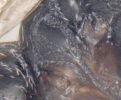Scientific name
Orius (Dimorphella) tantillus (Motschulsky)
Taxonomic position
Hemiptera: Anthocoridae
Diagnosis
Adult yellowish brown to slightly darker brown, all femora yellow to pale brown, hind pair sometimes darker. Labium reaching procoxae. Antenna exhibits sexual dimorphism, thinner and weakly club-shaped in female and uniformly thicker in males. Pronotum evenly and coarsely punctate, without long setae at anterior angles; callosities of pronotum weak or flatly convex, finely punctate, difvided
medially by a band of deeper punctures. Osteolar peritreme of metathoracic scent gland broader, curved forward with an enclosed, shiny area surrounded by strongly punctate or sculptured areas. Basal segment of female copulatory tube rather elongated, arising from mesal surface of intersegmental membrane. Male abdominal segments V-VIII strongly asymmetrical towards left. Male genitalia with left paramere three-pronged (from Hernandez, 1999).
 Head and thorax (dorsal view) Head and thorax (dorsal view)
 Osteolar peritreme Osteolar peritreme
Image
 Adult - dorsal view Adult - dorsal view
Distribution
Widely distributed in India. Also distributed in Sri Lanka, Thailand, Malaysia, China, Australia, Micronesia, Solomon Islands, Kenya, Nigeria, and Tanzania (Hernandez, 1999).
Biology / Hosts
Commonly collected on several plant hosts like sunflower, cotton, chillies, marigold,
etc. in association with thrips, mites, Helicoverpa armigera, etc. Technology for its mass production on UV-irradiated eggs of Sitotroga cerealella (Olivier) has been standardized at
NBAII (Tripti and Ballal, 2009).
References
- Hernandez, L.M. 1999. A review of the economically important species of the genus Orius (Heteroptera: Anthocoridae) in East Africa. Journal of Natural History, 33: 543-568.
- Muraleedharan, N. and Ananthakrishnan, T.N. 1974. New and little-known species of Orius Wolff from India (Hemiptera: Anthocoridae). Oriental Insects, 8(1): 37-41.
- Tripti, G. and Ballal, C.R.B. 2009. Protocols for the commercial production of Orius tantillus (Motschulsky) (Hemiptera: Anthocoridae). Journal of Biological Control, 23(4): 385-391.
|